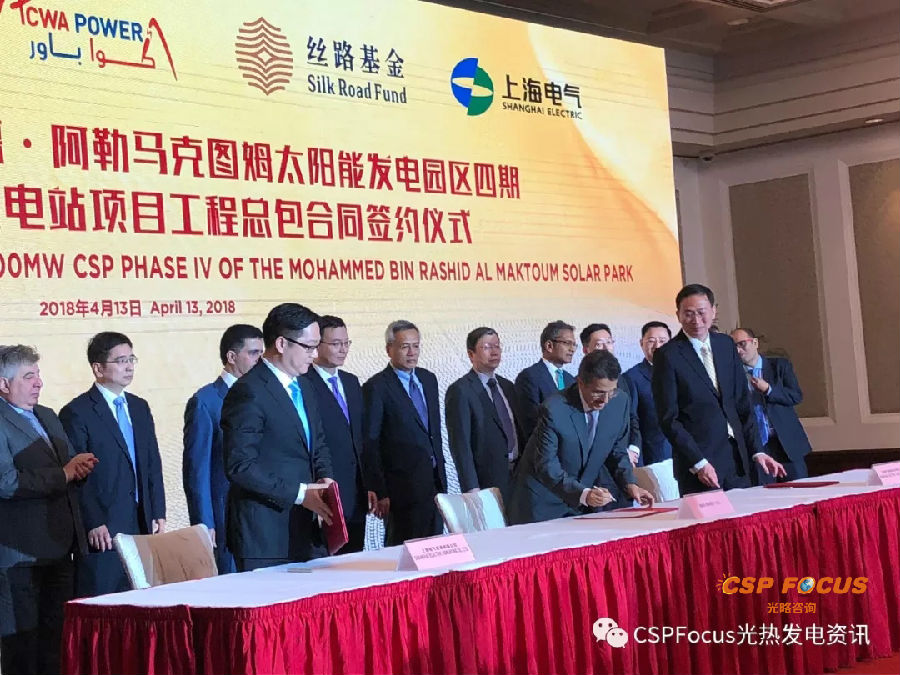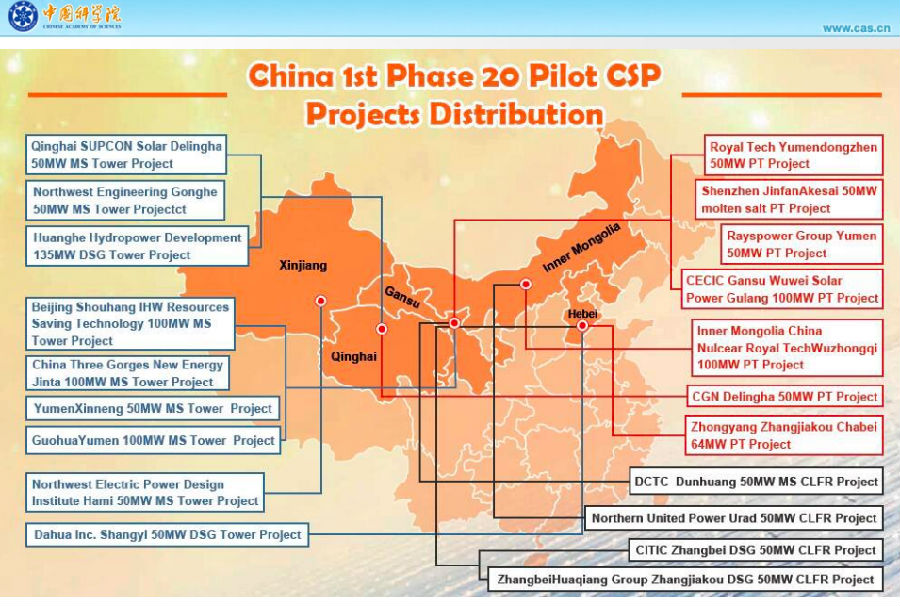Q&A: How Risk Mitigation Finance Can Cut CSP Costs
2019.09.17 From: SolarPACES

ACWA Power and Shanghai Electric sign an EPC agreement for a large scale CSP project for DEWA in the UAE
Cutting risk in financing will be the next key to further cut CSP costs, according to the author of Non-recourse project financing for concentrated solar thermal power
published in the journal Utilities Policy. Dr. Steven Geroe teaches
Energy and Environmental Law and Contract Law at Melbourne's La Trobe
Law School, and became interested in China's renewable energy finance
and investment while working for a Chinese investment law firm involved
in clean energy projects.
I noticed some of the CSP research papers you cited are written in Chinese characters. Do you read Chinese?
SG:
Yes, I lived in China and studied Chinese for about 20 years. I
interviewed Chinese energy related institutions because one of my
interests in the Chinese regulatory approach is how the Chinese are
utilizing special expertise in drafting renewable energy-related
regulation for consulting in the drafting process.
So my
researching is partly in Chinese and my Chinese research assistants – my
grad students help me in my understanding. I only practiced law briefly
a long time ago: I'm more interested in research and writing on
contracting law, energy and environmental law and international
investment.
One of the aspects that I am interested in is the
evolution of Chinese debt markets and forms of contracting and doing
business. So what it appears at the moment as the Chinese go global
strategy which has got several aspects most prominent now is probably
the silk Road the one belt one road project.
As they go global,
strategic investments in developing countries around the world are
giving Chinese businesses and financiers a lot of experience in
international forms of contracting and doing business, so I think that
is likely to be a driver in increasing integration of those kinds of
contracting. For example in non recourse financing on a domestic basis.
And
I think the evolution of the Chinese capital markets domestically is
likely to support that as well and also a long-term trend of the
reduction of foreign reserves as the proportion of GDP down from about
50% to about 28% now. it's probably driving an increasing openness to
international investors for large-scale domestic projects as well.
Why is de-risking finance important now for CSP growth?
SG:
Quite a lot of stars are aligning for CSP. It has already seen
dramatically falling technology costs due to the learning curve and mass
production, and then the recent spurt of large-scale deployment in
emerging countries like Morocco and China. There is a confluence of
factors so that a technology that has shown a lot of potential over the
years but never really had its time in the sun maybe having its time in
the sun now.
I think that there is now real potential emerging of
contractual and de-risking strategies and technology maturity making
CSP a viable investment carrier for institutional investors, as there’s a
number of risks specific to CSP, according to the EU report (link to
name) which did extensive surveys of a whole range of all the commercial
stakeholders.
Policy stability was the biggest risk they cited.
Technology risk was also key and so having performance guarantees was
contractually better for suppliers and technology providers in the EPC
contract. And revenue predictability, from having an adequate PPA, like
in the 35 year DEWA contract, is important in a non-recourse loan.
Your
paper notes that non-recourse financing increased from 16% in 2004, to
52% by 2015. Why does this kind of financing lower CSP costs?
SG:
Non-recourse loans are very good at spreading and allocating risks. You
have got a lot of big players on both sides; on the financing side,
typically syndicates of big international banks who are able to allocate
risks across a number of large institutions and on the investment side,
a consortium of investors who will also be pretty large-scale.
And
then through the web of contracting risk you are spreading risk to all
the contractors. And the contractors can be pretty large-scale as well
in terms of the EPC contracting for the building of the plant and the
operation and maintenance contracts in the PPA.
A specific
purpose vehicle – or SPV, is the central aspect of non-recourse
financing. The sponsors or investors set up a separate company as a
project company which holds the assets, so what that means is the
financiers can only sell off the assets of the project, but they don’t
have recourse to the investors themselves who Invested in the project
company.
International banks will do their due diligence and have
extensive security agreements covering the collateral of the SPV and
they may also have some direct contractual arrangements with the other
contractors. They have to do their due diligence that the project has
got enough in guaranteed cash flow so that they will get their money
back from the cash flow of the project.
To have a bankable
project – CSP or otherwise – you have to have very good risk allocation
management contractually and also a good backup in terms of de-risking
strategy.
So non-recourse financing is a fairly complex structure
with fairly high transaction fees but it has proven effective in
mobilizing very large-scale investments for high risk projects because
of its risk allocation capacity.
Where else has non-recourse finance been used?
SG:
Initially it was used in the oil and gas industry in the United States,
when there were fairly large investments in sort of hit-or-miss
projects. Non-recourse historically has been for larger scale – higher
risk projects so it is considered a useful structure four high risk
projects which have got good revenue generation potential.
So its
been a very common form of financing infrastructure in the energy
sector but it is being used in other large infrastructure construction
projects and more generally in a large range of areas; ports, hospitals,
roads, airports. A PPP structure – a public-private partnership
structure – quite often has a non-recourse aspect as well.
In
your paper you identified complementary debt guarantees as a good
pairing with non-recourse loans, noting its success in bringing down
costs in offshore wind financing. Which countries have tried debt
guarantees?
SG: Debt guarantees were pretty prominent in
American solar generally where the Obama administration stepped up in
response to the debt crisis. There was also a debt guarantee in one of
the largest CSP plants in the world, the MASEN contract for the 580 MW
Noor CSP plant in Morocco, and in that case the debt guarantee was to
cover the difference in prices between coal and CSP.
{The details are in the paper:
“The
170 MW Phase 1 of the project utilised a BOOT structure between the
Moroccan Agency for Solar Energy – MASEN, and ACWA Power Ouarzazate, a
special purpose vehicle incorporated under Moroccan law. ACWA is under a
turnkey contract to design, finance, construct, operate, and maintain
the power station. Its experience in solar investments in the Middle
East and Africa was also seen to limit the risk involved with MASEN’s
relative lack of experience in complex projects as the primary
off-taker. The debt financing of the project included a €200m
traditional loan by the African Development Bank (“AfDB”) to MASEN, plus
a €165m concessional loan by the African Development Bank Clean
Technology Fund (“CTF”) to MASEN.
Both loan amounts will be on lent by
MASEN to ACWA Power, which has primary responsibility to repay AfDB. The
first or intermediary off-taker is MASEN. As the intermediary
off-taker, MASEN re-sells the power generated to the Office National de
l’Electricité et de l’Eau Potable (“ONEE”), Morocco’s sole electricity
distribution utility. The first PPA between ACWA and MASEN is
twenty-five years based on production costs, at US$ cents 18.9 per kWh.
The second PPA, also for twenty-five years, applies to the on-selling by
MASEN to ONEE, and is based on the net rates applicable in Morocco. As
net rates applicable in Morocco (for coal-fired power) were expected to
be lower than (CSP) production costs, this created a revenue risk for
the project vehicle ACWA. This risk was addressed by a guarantee over
both loans by the Kingdom of Morocco to the extent of the
diferential
between the two PPA rates.”

China’s pilot CSP projects 2016-2020 IMAGE@CSP Focus
Policy stability is the other de-risking factor; I guess that is China's advantage?
SG:
Yes, the central government in China has had long-term targets which it
has taken seriously. That's really been the official position since I
think since the 2007 Chinese National Climate Change Plan when the
central government clearly recognized both the future and existing
impacts of climate change..
Environmental concerns are very
different in China because it is a key area of public concern as it has
direct health consequences, more with particulate pollution of water and
air, but that feeds through to the governments approach to
environmental issues. The Chinese are genuinely committed to reducing
emissions and to doing so with the most efficient technology in a
cost-effective manner.
The whole political dynamic around
renewable energy is very different from countries like North America and
Australia where we have had powerful incumbent fossil fuel industries
with fairly substantial political clout that makes them resistant to
change. Although there are both private sector and state-related fossil
fuel interests in China too, such interests are less intractable in
China, particularly at the central government level. So I don't think
there are any comparable political obstacles from the fossil fuel
industry.
However, there's clearly also a downside in terms of
central planning and overall coordination. They have serious
coordination difficulties. I think a pretty common example of that is
the trailing grid connection for wind turbines: they structured their
wind subsidies for construction rather than production. So there are
policy shortcomings.
Generally what happens in China across a lot of
industries anywhere from automotive to solar power is there tends to be
generous government subsidies and programs which create a rush into
industries and there is a kind of a stampede into industry followed by a
a very rapid shakeout so it's a lot of pain for a lot of companies and
that happened in solar PV.
Do
you expect the Chinese government will do anything to avoid winding up
with just one or two giant CSP firms left standing as weaker players are
weeded out?
SG: I think they'll genuinely allow or try to
facilitate direct competition between rival technologies and choose the
best. They are taking an experimental and empirical approach: using
their learning from these experimental projects and making decisions
down the line.
Market liberalization is their official state policy
driven through the central planning process, so more competition between
market-based entities, and breaking up entities and encouraging
competition. However that is a fairly stalled process, so there does
tend to be a lot of market domination by the big players.
Upcoming CSP events:
3rd CSP Focus Innovation 2019(Oct.24-25, Beijing China)
10th CSP Focus China 2020 (March, Beijing China)
More CSP news and reports please visit www.cspfocus.cn
or CSP Focus social media on LinkedIn, Twitter, Facebook.
More from CSP Focus
NextOn-site views on Morocco NOOR Ouarzazate 510MW Solar CSP Complex
ChumillasTechnology, in the largest Concentrated Solar Power plant in Latin America
DEWA opens R&D centre at Dubai concentrated solar power plant
DEWA launches tender for 900MW 5th phase of Mohammed bin Rashid Al Maktoum Solar Park
Technology to address climate change is Earth's biggest opportunity
Solargis illustrates solar resource assessment for China CSP projects
Leave your thoughts here
Reports(Member Only)
See more+-
CSP Focus Membership Proposals
We are now proposing CSP Focus Membership, hoping to better serve our members to keep pace with the latest updates of ongoing CSP projects worldwide, and to establish and maintain business relations with major shareholders of the projects. CSP Focus offers to Membership exclusive access to:1. Daily/Weekly update and analysis on CSP policies, projects, technologies, market trend and corporate relea
-
The Latest CSP Focus Monthly Update
Join CSP Focus Membership to Get the Latest CSP Focus Monthly Update December Edition.
-
CSP Project Monthly Update 2022 December Edition
CSP Focus is presenting CSP Project (China) Update 2022 December Edition.Detail report is available for CSP Focus Membership.
-
Presentations-CSP Focus China 2021
The Report is for CSP Focus Members only.
Upcoming Events
See more+-
12th CSP Focus China 2022
2022.04.21-22 Beijing
-
11th CSP Focus China 2021
2021.10.28-29 Beijing
-
10th CSP Focus China 2020
2020.10.22-23 Beijing, China
Project Updates
See more+-
Lanzhou Dacheng Dunhuang CSP Project
Asia Pacific-China,Operational,Parabolic Trough
-
Luneng Haixi 50MW Molten Salt Tower CSP Project
Asia Pacific-China,Operational,Power Tower
-
Dubai 950MW NOOR Energy 1 CSP+PV Project
MENA-UAE,Under construction,Power Tower
-
Power China Gonghe 50MW Molten Salt Tower CSP Project
Asia Pacific-China,Operational,Power Tower





